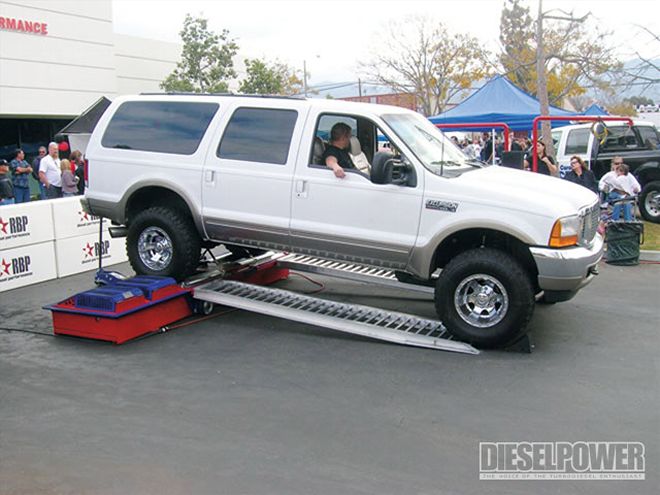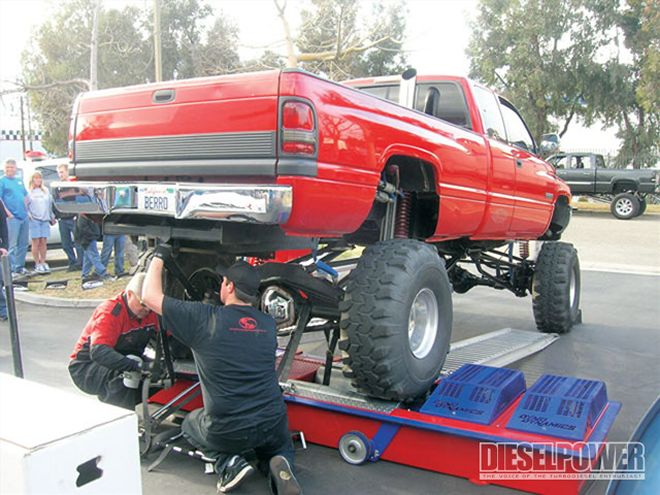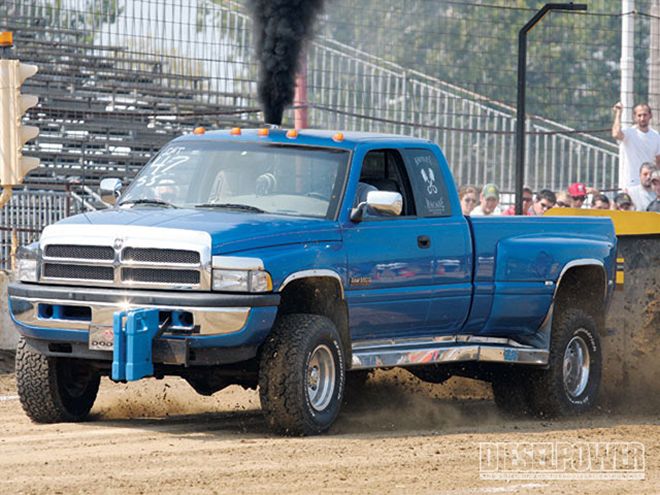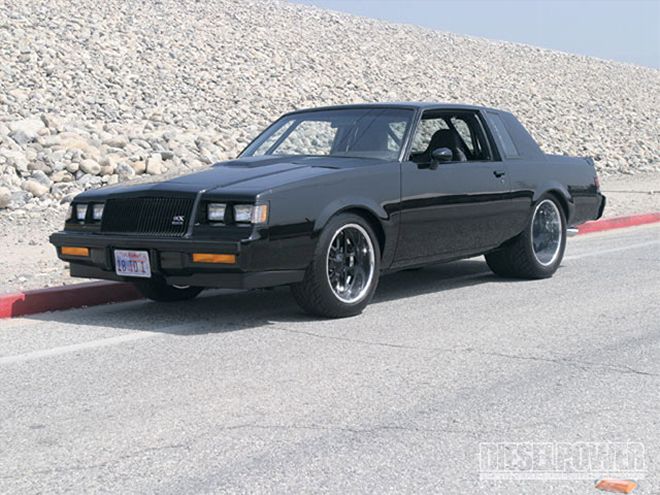
| diesel Calculations 101 ford Excursion
We know there are a lot of diesel junkies out there who are into math and physics, so we decided to put a few basic calculations in one place so everybody out there in reader land could have them handy. Math can teach us a lot about our diesel trucks-everything from projected horsepower, to how gear ratio changes can affect your cruising speed.
Cargo CapacityThis is a basic calculation for how much junk you can cram into your truck's bed. To calculate cargo capacity, just multiply the truck bed's inside length, by its width, by its height, and there you go. Knowing cargo capacity can be useful in answering questions such as "Can I haul a cord (4x4x8) of wood?" Having this calculation will tell you how many trips you'd need in order to haul the full load.
Gross Vehicle Weight Rating (GVWR)Speaking of cargo space, you also have to make sure you're not overloaded. All diesel trucks have a Gross Vehicle Weight Rating that lets you know how much weight you can carry before your truck becomes overtaxed. Because you can put so much more weight in the bed (because the engine is up front), front and rear weights are often very different. To use Feature Editor Mike McGlothlin's '97 F-350 as an example, his vehicle's GVWR is 9,200 pounds, but his Gross Axle Weight Ratings (GAWRs) are 4,600 pounds front, and 6,084 pounds rear, respectively. Notice that you can't simply add the front and rear GAWRs and get the GVWR, rather the front and rear numbers are the maximum amount of weight you can load over the front and rear axles as long as the total truck weight does not exceed 9,200 pounds.
Miles Per GallonThis one might be simple. Calculating miles per gallon is as easy as miles traveled divided by gallons used, right? Well yes, but you have to be pretty accurate. If you drive a short distance, or the pump automatically stops at a different point, you can be as much as 2-3 mpg off. Drive a long distance when calculating fuel economy, and fill up as carefully as possible.

| Although having monster tires might look cool, you may have to re-gear your truck so it stays in its operating range. Your speedometer will also be pretty far off until you fix it.
Tire Size, Engine Speed, and Gear RatioSo you've decided to put on 35-inch tires, and you want to know what you're new cruising rpm will be. Or you are sled pulling, and you want the top of Third gear at 4,000 rpm to give you 40 mph of wheel speed. What do you do? This calculation can help, but first notice that your gearing should depend on your desired engine speed. You'll gear extremely different on a 5,000rpm sled puller than you will in a 3,000rpm street truck. For example, let's take Project Rust Bucket. A Cummins engine seems to achieve its best fuel economy at about 1,800 rpm, so let's see how far off we are. Here's the formula: RPM equals speed (75 mph) multiplied by the transmission gear ratio (1:1 for high gear) multiplied by the rear gear ratio (3.07) multiplied by 336 divided by tire diameter (31 inches). So 75x1x3.07x336/31=2,495 rpm. Ouch, we're not even close to getting good fuel economy. But what if we had an Overdrive, which would give us a .70 transmission ratio? That's 75x0.70x3.07x336/31=1,746 rpm, which now means we'd almost be under geared. But the good news is that at our redline (3,000 rpm), we'd be able to go almost 130 mph. Tire size also makes a difference, as our cruising speed if we had the same setup with 35-inch tires would be 75x1x3.07x336/35=2,210 rpm. Gear ratio, tires changes, engine speed, and ground speed can all be calculated from these simple formulas, depending on what you want to know.
Speedometer CorrectionsOK, so you just put some 37-inch tires on, but you don't know how fast you're going anymore because your speedometer still thinks everything is stock. Let's say you're driving 60 mph in a 65mph zone just to be safe. How fast are you really going? The formula is your new tire diameter (37) divided by your old tire diameter (31) multiplied by your indicated mph (60). So, 37/31x60=71.6 mph. Sorry, you're speeding! To find out what 65 mph will look like on your speedometer, simply rearrange the calculation: 31/37x65=54.4 mph. Notice the new and old tire diameters are reversed in this situation.
Calculating Horsepower and TorqueEverybody wants to know how much power and torque their diesel makes. But how? Well, the easiest way is to go to a chassis dyno, but there are other ways. A truck with huge turbos might make much more boost at the track, so a chassis dyno might not load it enough to produce its true power numbers. Before we get into horsepower calculations, we'd like to point out that torque is simply horsepower multiplied by 5,252 divided by rpm. So if your truck makes 560 horsepower at 3,200 rpm, your torque is 560x5,252/3,200=919 lb-ft of torque. Sometimes your truck's torque peak may be 500 rpm or so before your horsepower peak, so let's say the same truck makes 530 hp at 2,700 rpm. That means the torque at 2,700 rpm would be 530x5,252/2,700=1,030 lb-ft.

| Sled pulling is a sport where gearing is all important. Pullers juggle transfer case ratios, tire sizes, and final drive gears, all in an effort to squeeze every last inch of distance out of their combination.
Calculating Horsepower from Quarter-Mile Elapsed Time and SpeedYou can also calculate your horsepower from quarter-mile passes. There are about a zillion horsepower calculators online, and almost all of them are based on a simple formula that was developed by Patrick Hale back in the 64-bit processor days. He found a calculation that, while not completely accurate, is pretty close. It's as simple as elapsed time divided by 5.825. That result is cubed (multiplied by itself 3 times) then the vehicle weight is divided by the result. Confusing? We'll use our results from an '08 Ford Super Duty diesel we tested back in July 2007 as an example. The test rig weighed a whopping 8,000 pounds with driver and fuel, and made 290 rear wheel horsepower on a chassis dyno. It also ran a 15.9-second pass at 84 mph at the dragstrip. In starting with our formula, we first have to divide 15.9 by 5.825 which gives us 2.73. Now take that and multiply it by itself three times (2.73x2.73x2.73). That result is 20.346. Now take the weight and divide by the result: 8,000/20.346=393 hp. But wait, we're not done! That 393 hp is flywheel horsepower. Since there is roughly a 20% loss to the rear wheels, we then take 393x.8=312 rear wheel horsepower, which is fairly accurate. This formula also works for faster trucks. Micheal Tomac ran an 11.55 in the quarter-mile in the second Diesel Power Challenge, and made 750 hp on the chassis dyno. Since we knew his truck weighed about 7,200 pounds, we can figure out his horsepower 11.5/5.825=1.974. 1.974x1.974x1.974=7.692. 7,200/7.692=936 flywheel hp. 936x.8=748 rear wheel horsepower, only 2 hp off! Since this formula assumes perfect traction, gearing, and turbo spooling, the calculation can often be a little off. On one pass, we left our '08 Ford (same one as mentioned earlier) in two-wheel drive at the dragstrip and ran a traction-limited 17.2-second pass. Since traction was a limiting factor, our numbers will be off: 17.2/5.825=2.953x2.953x2.953=25.751. 8,000/25.751=310 flywheel hp. 310x.8=248 rear wheel horsepower. Since our traction was less than perfect, so were our numbers.
ConclusionIn fact, that last statement can apply to any type of calculation that is entered into a formula-the result will only be as good as the numbers that are entered. If you are off on your numbers, even a lisican make a big difference in the end result. So enjoy your newfound powers of calculation, and don't be afraid to send us some diesel math of your own.
 | diesel Calculations 101 ford Excursion
We know there are a lot of diesel junkies out there who are into math and physics, so we decided to put a few basic calculations in one place so everybody out there in reader land could have them handy. Math can teach us a lot about our diesel trucks-everything from projected horsepower, to how gear ratio changes can affect your cruising speed.
Cargo Capacity
| diesel Calculations 101 ford Excursion
We know there are a lot of diesel junkies out there who are into math and physics, so we decided to put a few basic calculations in one place so everybody out there in reader land could have them handy. Math can teach us a lot about our diesel trucks-everything from projected horsepower, to how gear ratio changes can affect your cruising speed.
Cargo Capacity


 | Although having monster tires might look cool, you may have to re-gear your truck so it stays in its operating range. Your speedometer will also be pretty far off until you fix it.
Tire Size, Engine Speed, and Gear Ratio
| Although having monster tires might look cool, you may have to re-gear your truck so it stays in its operating range. Your speedometer will also be pretty far off until you fix it.
Tire Size, Engine Speed, and Gear Ratio | Sled pulling is a sport where gearing is all important. Pullers juggle transfer case ratios, tire sizes, and final drive gears, all in an effort to squeeze every last inch of distance out of their combination.
Calculating Horsepower from Quarter-Mile Elapsed Time and Speed
| Sled pulling is a sport where gearing is all important. Pullers juggle transfer case ratios, tire sizes, and final drive gears, all in an effort to squeeze every last inch of distance out of their combination.
Calculating Horsepower from Quarter-Mile Elapsed Time and Speed